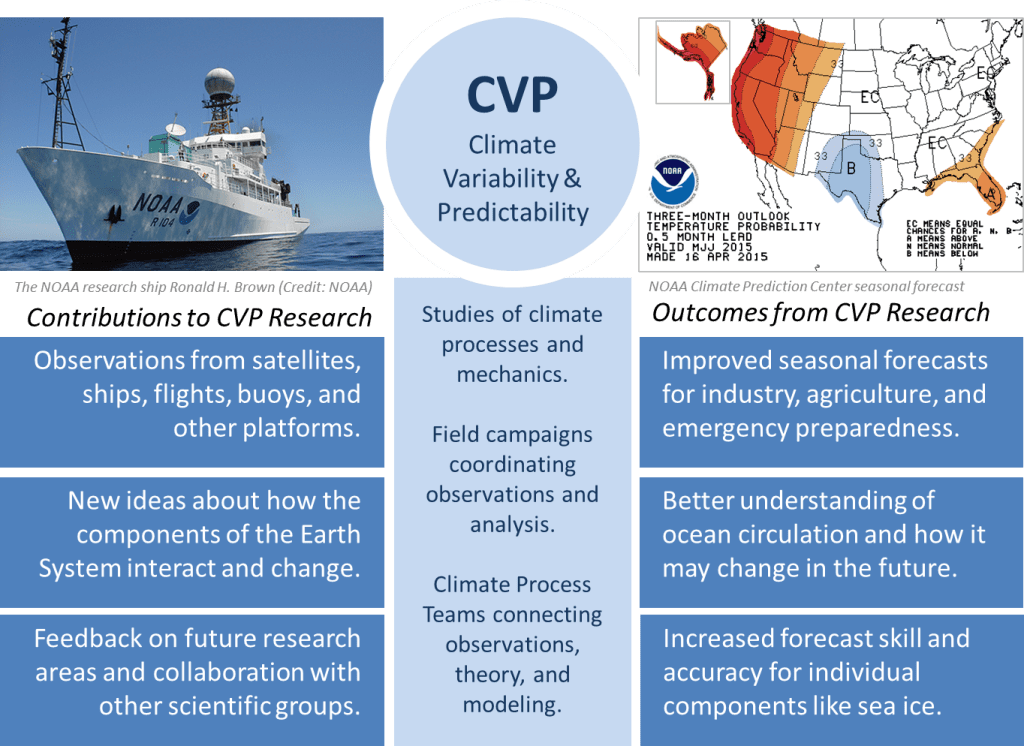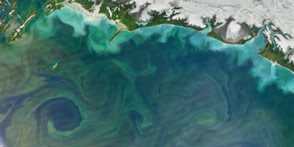Climate Variability & Predictability (CVP)
The Climate Variability and Predictability (CVP) Program supports research that enhances our process-level understanding of the climate system through observation, modeling, analysis, and field studies. This vital knowledge is needed to improve climate models and predictions so that scientists and society can better anticipate the impacts of future climate variability and change. CVP-supported research underpins many of the environmental assessments, weather forecasts, and climate projections used by the nation to make decisions about infrastructure development, aviation, farming, ecosystem management, emergency preparedness, and other critical areas.

The Climate Variability and Predictability (CVP) Program supports research that enhances our process-level understanding of the climate system through observation, modeling, analysis, and field studies. This vital knowledge is needed to improve climate models and predictions so that scientists and society can better anticipate the impacts of future climate variability and change. CVP-supported research underpins many of the environmental assessments, weather forecasts, and climate projections used by the nation to make decisions about infrastructure development, aviation, farming, ecosystem management, emergency preparedness, and other critical areas. CVP maintains a portfolio of projects intended to examine the large scale components of the earth, how they influence each other, guided by the following questions:
- How can we better understand and anticipate the global and regional impacts of climate variability and change?
- What foundational knowledge, through observation, modeling, analysis, and field studies, do we need in order to improve climate models for short-term predictions and longer-term projections, which will improve our ability to assess risk and inform decision-making?
- How can we close the predictability gap between weather models and climate models to inform areas of progress toward seamless weather-to-climate modeling for temperature, precipitation, and other information important to society and decision-making?
To achieve its mission, the CVP Program invests in NOAA mission-critical research, which is carried out at NOAA and other federal laboratories, NOAA Cooperative Institutes, and academic institutions. The Program also coordinates its sponsored projects with major national and international scientific bodies including the World Climate Research Programme (WCRP) – especially CLIVAR (Climate and Ocean Variability, Predictability and Change) and GEWEX (Global Energy and Water Cycle Exchanges) programs – and the U.S. Global Change Research program (USGCRP).
In order to to understand the dynamics of, and sources of predictability in, the coupled ocean-atmosphere-land-ice system across all climate time scales, CVP supports current projects that:
- Explore existing biases (errors) in weather and climate model simulations with a focus on processes, in order to generate new discoveries and refine existing understanding of these processes.
- Conduct field studies to improve our understanding of how the ocean, atmosphere, land, and cryosphere work together to make the weather and climate that we live in.
- Research climate variability on longer (up to multi-decadal) timescales through improved understanding of such phenomena as the Madden-Julian Oscillation, El Niño/La Niña (ENSO), and Atlantic Meridional Overturning Circulation (AMOC).
- Focus on regional climate variability and its connections to the global weather and climate system, such as interrogating the mechanisms that affect Arctic temperatures and sea ice, climate impacts of fisheries, explaining extremes, and the potential to improve regional predictions.
CVP’s Role in the Climate Program Office
The CVP Program is a critical component of the integrated research enterprise at the NOAA Climate Program Office (CPO), and maintains important connections to the other CPO program areas. In order to improve understanding of the climate system and its representation in models we need high-quality, consistent, long-term observations of the many parameters of the climate system.
The research generated by CVP-funded projects such as the improved understanding of the climate system, and the many high-quality, high-frequency regional observations are then used by scientists supported under the MAPP program (Modeling, Analysis, Predictions and Projections) to strengthen our ability to predict and project changes in the climate system through modeling and analysis. These scientists formulate and implement enhancements to climate models and validate these enhancements against observations.
The outcomes of modeling and analysis inform COM and CVP scientists by demonstrating where there are gaps in the data we collect and in our understanding of how climate processes work. Outcomes from the COM, CVP, and MAPP programs directly align with NOAA’s mission of science, service, and stewardship, and are connected to the societal need for better predictive capabilities. Through the Climate and Societal Interactions (CSI) division, NOAA-supported research is applied to a diverse set of problems from drought to extreme heat. Through the Communication, Education, and Engagement Division (CEE), the output of CPO is shared and tailored to many different user groups. The discoveries and updates made by CVP-supported scientists are explained and applied to a wide audience by CSI and CEE.
Altogether, the programs within CPO form a network of functional areas that support different elements of scientific research, development, and operationalization of our knowledge of the earth system. CVP’s role is to draw from both environmental and societal inputs to advance understanding of climate for better informed predictions, responses, and resilience to climate.
CVP engages across OAR Programs and Labs: Global Ocean Monitoring and Observation (GOMO) is tasked with supporting observing and monitoring systems of the ocean. Observations and data products supported by GOMO are used by CVP-supported scientists to build improved theories for the complex dynamics of the many components of the climate system. The primary area of engagement between CVP and GOMO are TPOS 2020 (Tropical Pacific Observing System 2020, TropicalPacific.org) and coastal inundation-sea level.
CVP engages with OAR Laboratories on many topics. Please see the CVP funded projects page for details and the NOAA OAR Laboratories page for lab locations.



